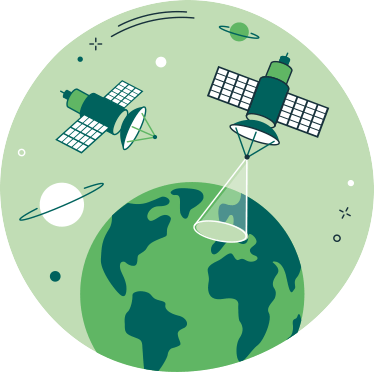
Environmental observation involves collecting and monitoring information and data regarding changes and trends in industrial, economic, and global environments. These pieces of data help researchers understand changing environments to inform potential changes in things like climate change policies and disaster relief plans.[1]
Earth Observation (EO) is defined as the process of acquiring observations of the Earth’s surface and atmosphere via remote sensing instruments. The acquired data is usually in the form of digital imagery.[2]
The value of Earth Observation for climate action
EO satellites have been essential to identifying and monitoring climate change and it supports mitigation and adaption measures by providing vast amount of EO data.
What are the three key benefits of Earth observation for local authorities?
Satellites watch over the Earth continuously, helping to monitor, understand, model, predict and act on climate change and its related challenges. EO data can be easily combined with in situ environmental measurements, along with artificial intelligence, to deliver actionable information to support decision-making for a neutral future.
Space data has an untapped potential to help achieve a better understanding through modelling, allowing predictive forecasts, and supporting policy formulation, implementation, monitoring and evaluation.
The PROTECT consortium aims at steering the uptake of innovative, fit-for-purpose and cost-effective EO based climate services by sharing relevant state of the art of the climate services market and allowing potential public procurers to better assess climate services’ benefits and potential.
The domains we are focusing on for the EO climate services areas it follows:
- Energy and utilities
- Sustainable urban communities
- Marine and coastal environment
- Agriculture, forestry, and other land uses
- Security and civil protection
Download the PROTECT Project Policy Briefs on Earth Observation for Local Authorities:
- PROTECT Policy Brief: Earth Observation for Agriculture, Forestry, and Other Land Use (pdf)
- PROTECT Policy Brief: Earth Observation for Civil Security and Protection (pdf)
- PROTECT Policy Brief: Earth Observation for Energy and Utilities (pdf)
- PROTECT Policy Brief: Earth Observaiton for Marine and Coastal Environments (pdf)
- PROTECT Policy Brief: Earth Observation for Sustainable Urban Communities (pdf)
More information on this topic is available at:
- European Commission: Knowledge Centre on Earth Observation
- European Union Agency for the Space programme:https://www.euspa.europa.eu/
- Group On Earth Observations (GEO):https://earthobservations.org/index.php
- Copernicus Climate change service: European state of the Climate 2021
- Eurisy : Space for climate challenges
- Citizen observation and in situ components: https://insitu.copernicus.eu/news/new-directions-for-in-situ-data
- Examples of innovative Earth Observation services: https://business.esa.int/projects
[1] Faculty of Science, University of Alberta, Environmental Observation and Modelling | Faculty of Science (ualberta.ca)
[2] European Space Agency, Newcomers Earth Observation Guide | ESA Business Applications
